I’ve always been drawn to sunny days—the kind that wraps you in warmth and fills the world with a sense of ease. Sunshine brings out a lightness in people, a bounce in their step, and a sense of optimism in the air. But in Kamikatsu, tucked deep in the mountains, clouds often linger. Rain feels like a constant companion.
As the rainy season nears, warmer days quietly dissolve into long, wet stretches, and life moves at a slower, more reflective pace. Early on, I found myself swayed by the melancholy of rain, feeling moments of sadness and apathy pulling me down. But nearly four years on, I've come to see the rain differently—not as something to endure, but as something that reveals a quieter kind of beauty.
Curiosity and perspective, I’ve learned, can transform how you see the world. For me, the rain’s gift is the fog. Each rainfall weaves a dense, mystical layer of fog that hugs the mountains like a protective embrace. Watching the fog rise and billow from the mountaintops, stretching and blending into the air, is a quiet marvel. It doesn’t present itself in defined shapes like the fluffy cumulus clouds of summer skies. Instead, it’s a diffuse presence, something that can only be understood by stepping back and viewing the landscape as a whole.
Curiosity and perspective, I’ve learned, can change everything. For me, the rain’s gift is the fog. Each downpour gives rise to a dense, drifting mist that clings to the mountains like a protective shawl. Watching the fog rise and billow from the mountaintops, stretching and blending into the air, is a quiet marvel. It doesn’t present itself in defined shapes like the fluffy cumulus clouds of summer skies.
The fog invites stillness. It reminds me to pause and observe the world with a wider and softer gaze.
A new perspective on rainy days came to me through a friend who runs the only café in our village. She once told me she prefers rain over sunshine. When I asked why, she smiled and said, ‘because I love the sound of it’.
In this season, deep in the heart of spring, the sound of rain harmonizes with the croaks of frogs. I can almost see the little green frogs dancing joyfully in the puddles. Inspired by her appreciation, I’ve started listening more closely to the rain.
Inspired by her appreciation, I’ve started paying closer attention to the sound of rain, noticing how it changes depending on where it falls. On my roof, the raindrops make a resonant, echoing sound as they hit the kawara, the traditional clay tiles of Japanese architecture.
She also told me that rainy days offer her the perfect excuse to turn inward. She doesn’t feel the usual tug to be social—the rain becomes a gentle closed sign, giving her permission to stay in, sip coffee, and read in the quiet company of herself. I understood exactly what she meant. Rain can be a soft nudge toward stillness and that solitude can be nourishing.
Harvesting takenoko
If sakura and other blossoming treetops are the visual markers of spring, then the abundance of sansai (山菜, mountain vegetables) and takenoko (たけのこ, bamboo shoots) mark the season by taste. Every spring, I feel a rush of excitement at the thought of foraging in the mountains.
When people think of Japan, an image that often comes to mind is the dense, emerald-green bamboo forests that seem to stretch endlessly. But what many don’t realize is how bamboo looks in its earliest form, when it first begins to emerge from the earth. While most sansai disguise themselves, blending in as tiny green buds or shoots that could be mistaken for weeds, takenoko stands out. It’s unmistakable—an easily identifiable young shoot of a bamboo plant.
The Japanese word takenoko translates directly to “bamboo's child”, and we've taken to affectionately calling it “baby bamboo”. When it first pokes through the ground, takenoko is covered in a tough, slightly fuzzy outer layer that feels more like a coarse doormat than tree bark. Its cone-like shape tapers off at the top, which is often crowned with sprouting, delicate young leaves.
Spring’s arrival is a feast for the senses—its beauty not just seen but tasted through these incredible gifts of nature!
Before moving to Japan, growing up in Canada, my encounters with takenoko were few and far between. Occasionally, I’d spot a sliver of bamboo shoot tucked as a garnish in a miso soup or a stir-fried vegetable dish. Even rarer was seeing takenoko for sale—I’d only ever come across it vacuum-sealed or canned, never fresh, and certainly never with its fuzzy, natural "coat."
Of course, grocery stores in North America (and elsewhere) have evolved significantly over the past decade. With the increasing availability of global ingredients and a growing interest in diverse cuisines, it’s quite possible that fresh takenoko can now be found in specialty Asian markets or even larger chain stores.
To harvest takenoko, we use an L-shaped tool, much like a garden hoe, to carefully dig and loosen the bamboo shoot from the soil. It’s a hands-on and satisfying process, made even more rewarding by the discovery of each new sprout peeking through the earth.
While writing this, I learned that takenoko isn’t just a shoot—it’s part of a rhizome, a fascinating root-like structure. Rhizomes are essentially a network of underground stems rather than a centralized root system like a tree. This unique structure helps plants like bamboo spread rapidly and thrive in diverse environments.
Preparing and cooking the takenoko
Sil seemed to enjoy in the harvesting, while I’ve always been more fascinated by the preparation and cooking of foraged foods.
I had imagined we’d come home with two or three bamboo shoots at most. But Sil zig-zagged on/around the mountain, digging over a dozen. I suddenly realized my pot at home could barely fit even one.
Thankfully, a local friend who runs the only bar in the village kindly offered to help. He guided us through the process of preparing takenoko.
Once harvested, takenoko are typically boiled either with their tough, outer skin intact or peeled beforehand. Some locals believe keeping the skin on preserves the rich umami flavor, while others prefer peeling to save space, especially for larger shoots.
However, preparing takenoko involves more than just boiling—it’s about removing the egumi, or astringency, that can make the taste unpleasant. Egumi is a kind of bitterness that not only affects flavor but leaves a dry, puckering sensation in your mouth. It’s a characteristic of many sansai (mountain vegetables) and requires careful preparation to transform them into something enjoyable.
With guidance, we started the meticulous process of boiling and preparing the bamboo shoots. It felt like a small ritual, connecting us to centuries-old culinary practices designed to make the most of nature’s gifts.
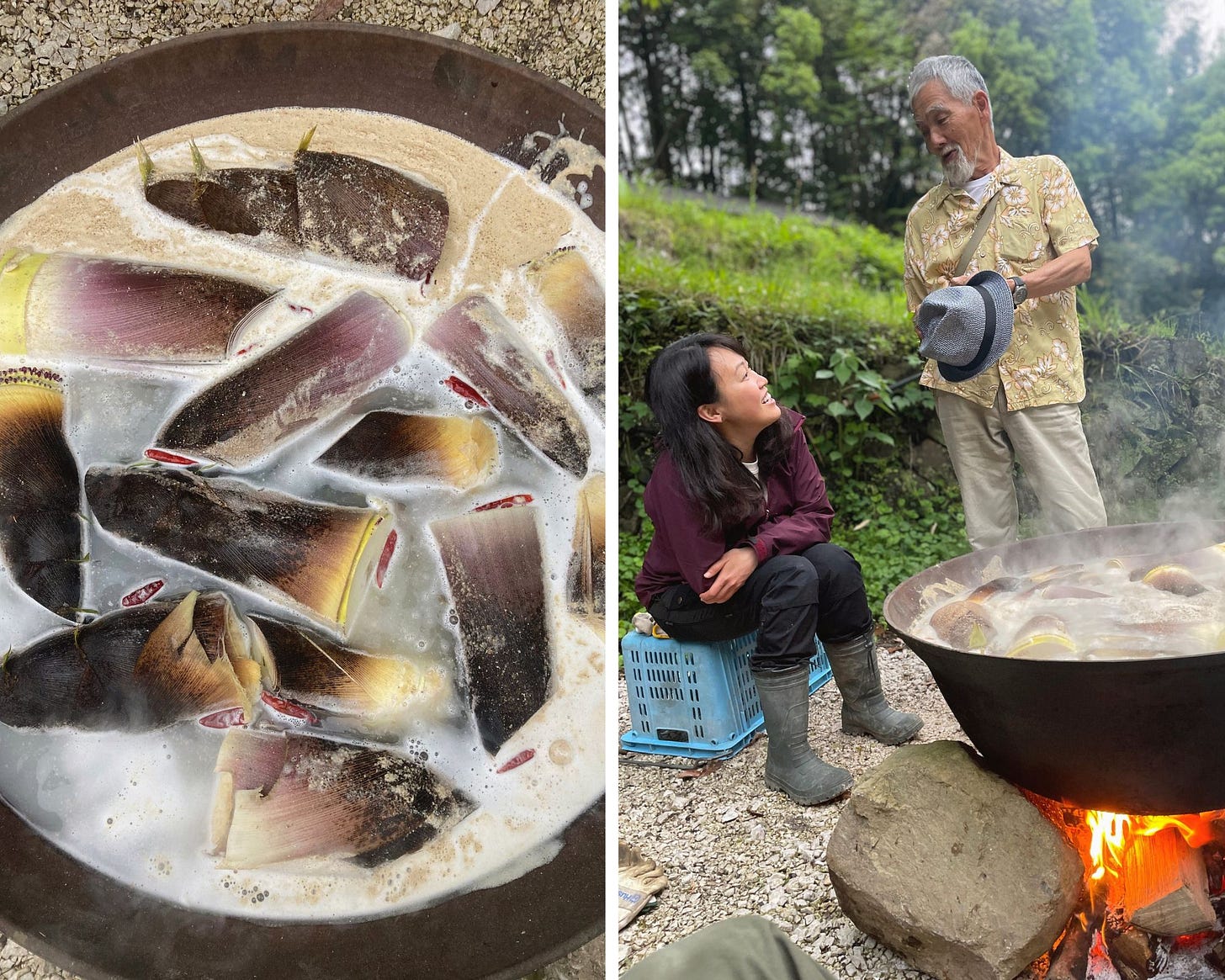
To make takenoko edible, we start by boiling it in water, adding a handful of rice bran and several dried chili peppers to the pot. The rice bran creates a mildly alkaline solution that helps remove the astringency, or egumi. The purpose of the chili peppers remains a bit of a mystery—perhaps tradition or subtle flavor enhancement—but they’ve long been part of the process.
After boiling the takenoko for several hours, we reduce the heat and let them simmer overnight, soaking in the warm water for over 8 hours. By morning, the transformation is complete. Peeling away the tough, outer layers reveals a pale yellow bamboo shoot, tender to the touch and ready to be incorporated into various dishes.
Takenoko can be prepared in many ways: simmered in soups and umami-rich broths, coated in batter and fried as tempura, or stir-fried like other vegetables. One of the most iconic dishes is takenoko gohan (たけのこご飯), or bamboo shoot rice. This comforting dish pairs freshly cooked rice with hearty chunks of bamboo shoots, creating a delightful balance of textures and flavors. The subtle sweetness of shinmai (new rice) combined with the earthy, nutty notes of takenoko makes takenoko gohan a celebration of spring’s bounty in every bite.
It’s likely fresh takenoko is not available to you, but if you can find a store-bought equivalent or replace it with a spring, earthy, vegetable like asparagus or baby corn, I imagine it could be just as delicious.
Thank you for reading this week’s post! It means a lot to me to have your support.
May your week be filled with a curious spirit—to ask questions, seek new and different perspectives that make us think, reflect, write, and engage in conversations in more thoughtful ways.
For those based in Japan, enjoy the rest of your Golden Week holidays, a set of four consecutive national holidays. May 5 celebrated Children’s Day (こどもの日 kodomo no hi) where there’s a custom, dating back to the Edo period in the 1600s, of hanging koinobori (carp streamers) for a sign of courage and strength because of the koi fishes ability to swim upstream. Pictured below is the carp streamers hung over the main river in Kamikatsu.
Have a beautiful week ahead!
With love,
Kana


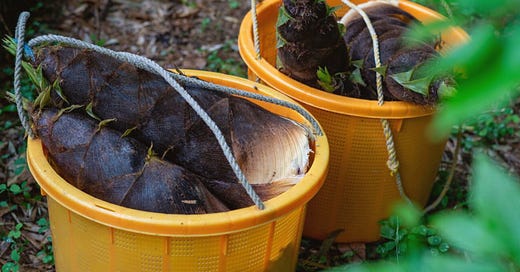


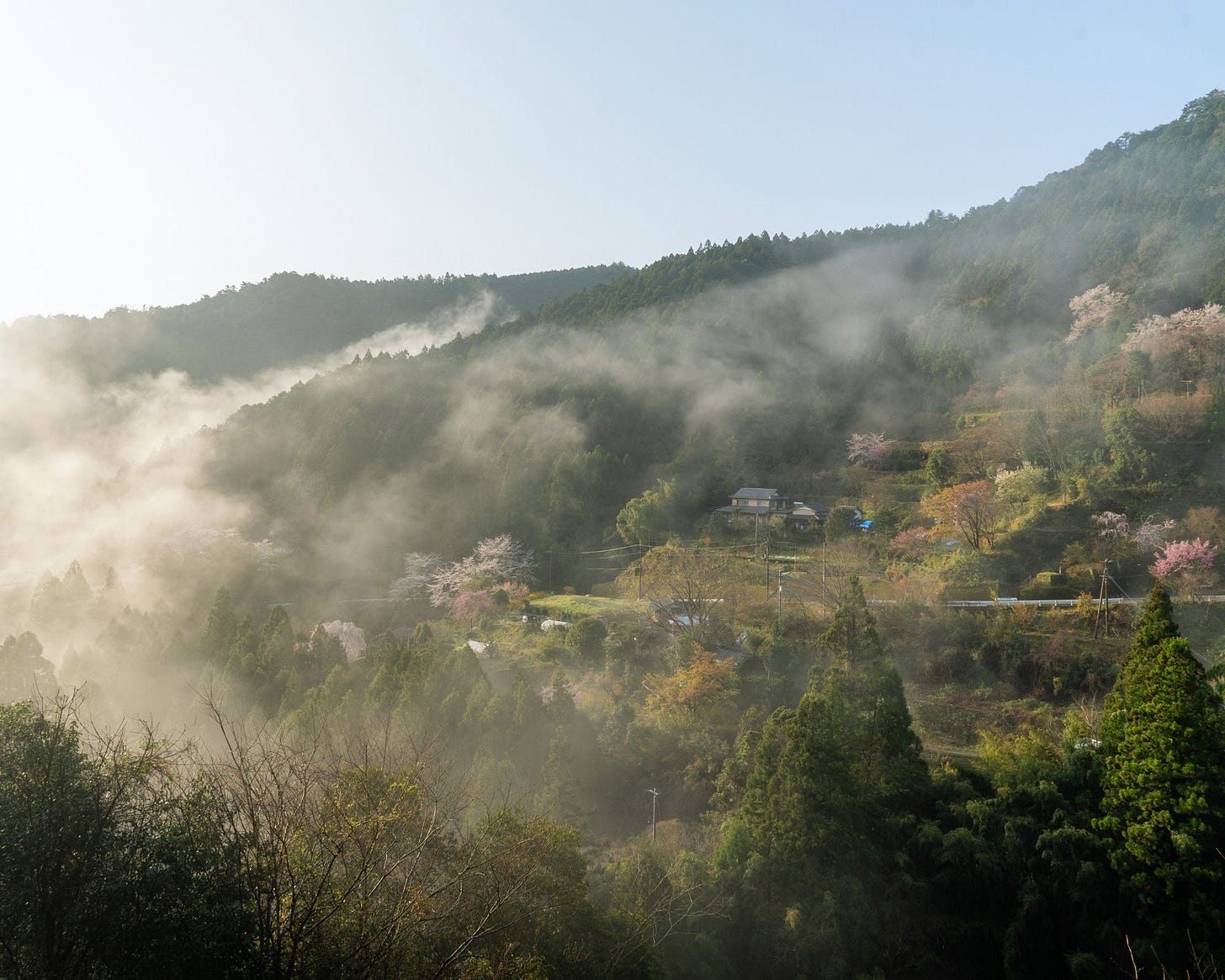

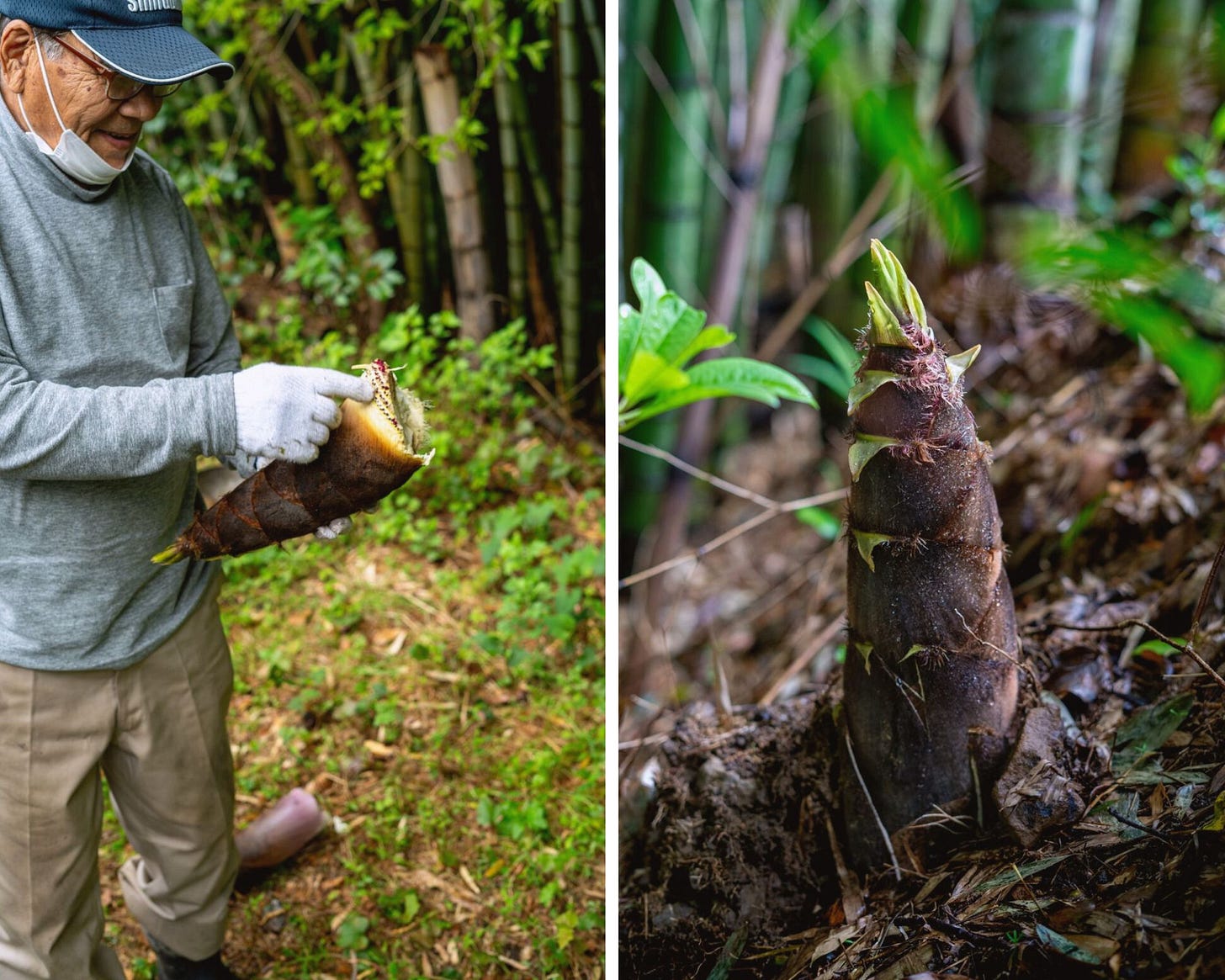
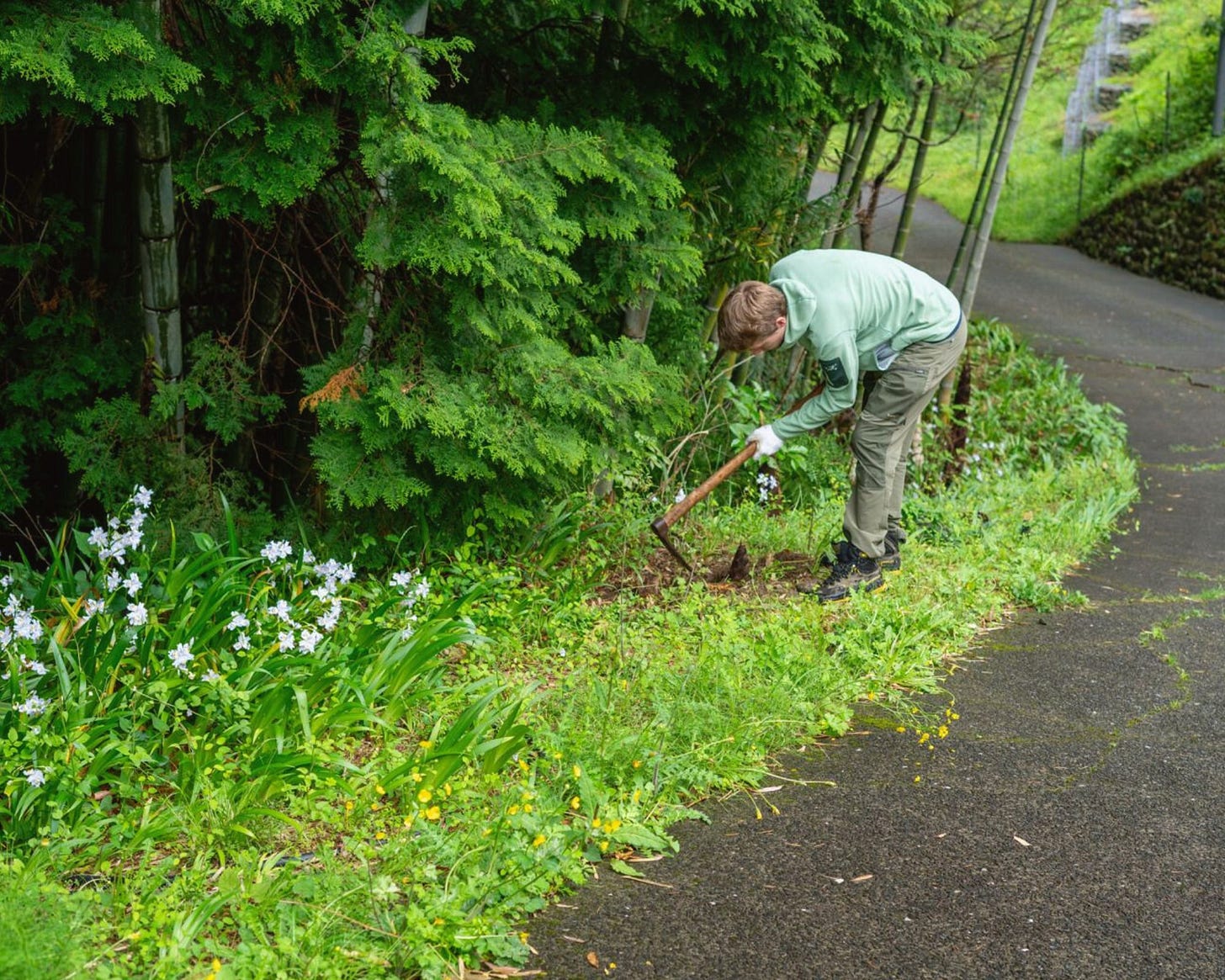


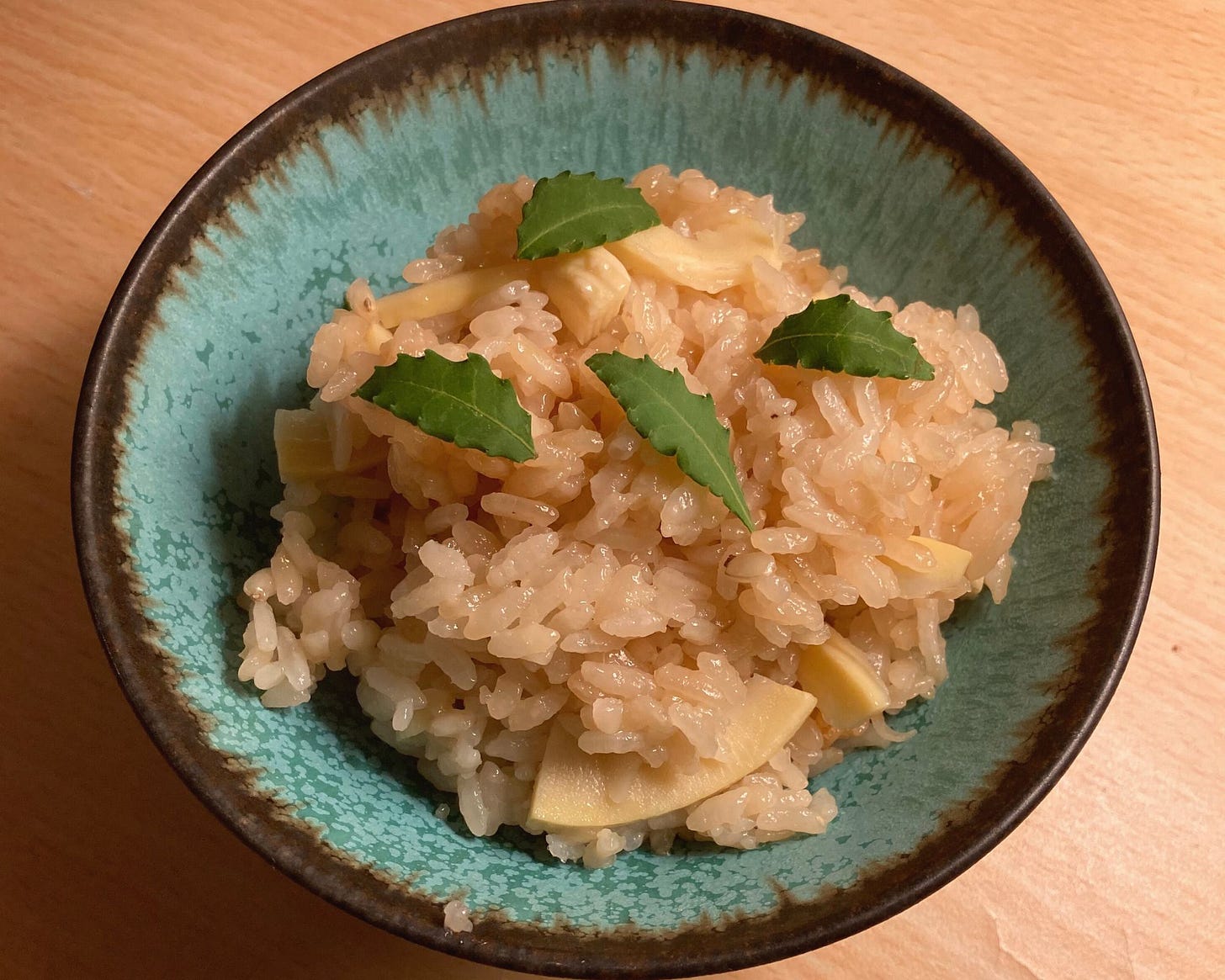

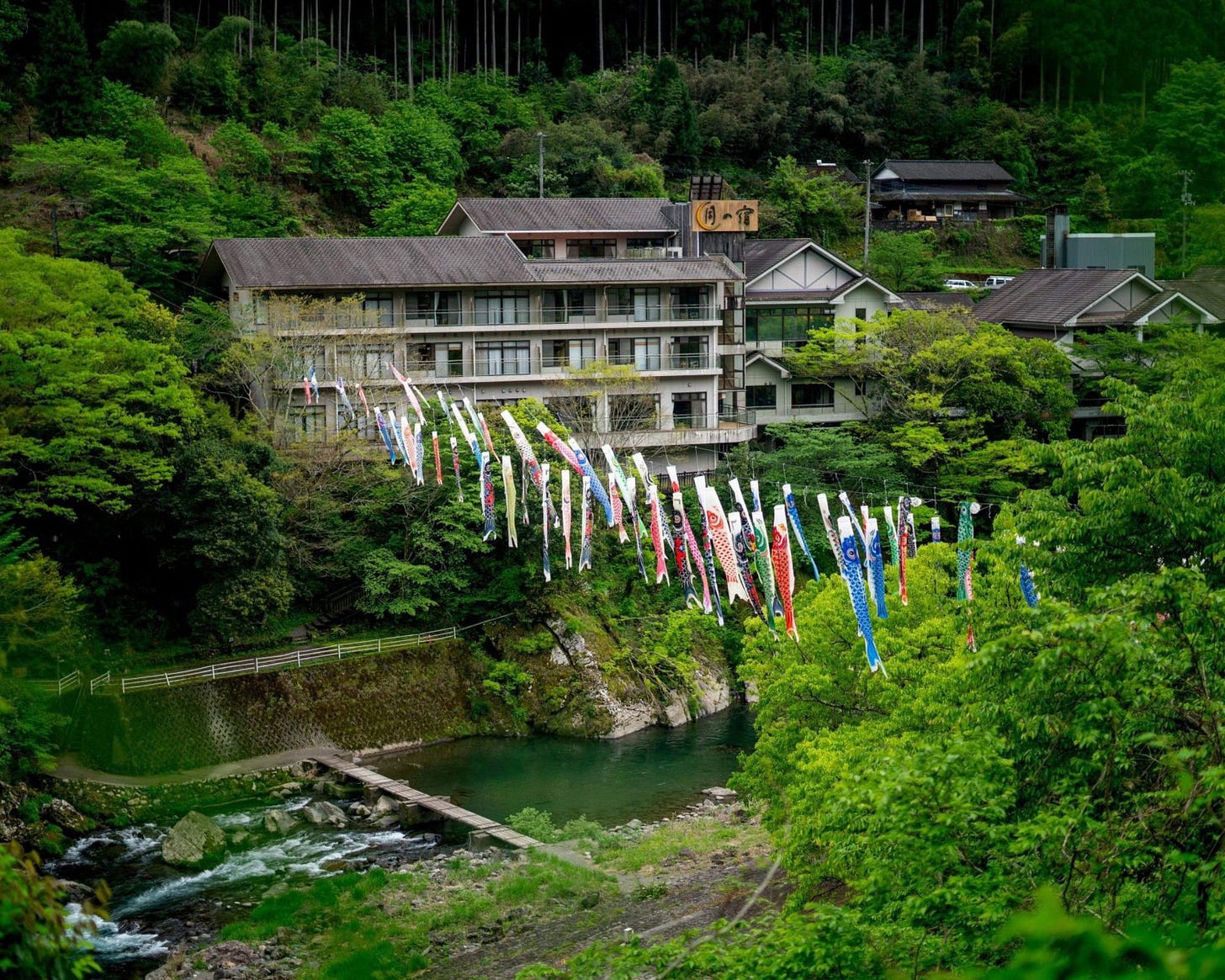
Love this post, Kana! I don't remember if I told you or not but a few months ago my partner and I moved up to Glasgow! We've had our share of overcast, rainy, foggy, and overall gray days — far more than we experienced in (apparently) sunny Cambridge! So reading through your reflections on the beauty the mist, the condensation, and the precipitation brings was so lovely to read!
Also, I'm green with envy at that beautiful bowl of baby bamboo rice :) It must taste so good to eat the fruits of your labor! (I can only imagine if you eat it with the rice you've grown yourself how good it must be!)
Sending you loads of love across the pond <3
I feel like I have been transported deep into the mountains of Shikoku. Thanks for the vivid description.